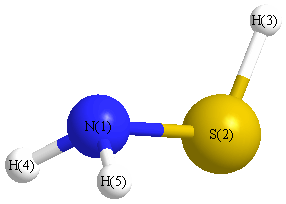Jump to
S1C2
Energy calculated at QCISD(T)=FULL/aug-cc-pVTZ
| | hartrees |
|---|
| Energy at 0K | -454.255358 |
| Energy at 298.15K | -454.259110 |
| HF Energy | -453.746886 |
| Nuclear repulsion energy | 57.652382 |
The energy at 298.15K was derived from the energy at 0K
and an integrated heat capacity that used the calculated vibrational frequencies.
Vibrational Frequencies calculated at QCISD(T)=FULL/aug-cc-pVTZ
| Mode Number |
Symmetry |
Frequency
(cm-1) |
Scaled Frequency
(cm-1) |
IR Intensities
(km mol-1) |
Raman Act
(Å4/u) |
Dep P |
Dep U |
|---|
| 1 |
A' |
3545 |
3545 |
|
|
|
|
| 2 |
A' |
2680 |
2680 |
|
|
|
|
| 3 |
A' |
1632 |
1632 |
|
|
|
|
| 4 |
A' |
1045 |
1045 |
|
|
|
|
| 5 |
A' |
887 |
887 |
|
|
|
|
| 6 |
A' |
663 |
663 |
|
|
|
|
| 7 |
A" |
3621 |
3621 |
|
|
|
|
| 8 |
A" |
1137 |
1137 |
|
|
|
|
| 9 |
A" |
423 |
423 |
|
|
|
|
Unscaled Zero Point Vibrational Energy (zpe) 7817.0 cm
-1
Scaled (by 1) Zero Point Vibrational Energy (zpe) 7817.0 cm
-1
See section
III.C.1 List or set vibrational scaling factors
to change the scale factors used here.
See section
III.C.2
Calculate a vibrational scaling factor for a given set of molecules
to determine the least squares best scaling factor.
Geometric Data calculated at QCISD(T)=FULL/aug-cc-pVTZ
Point Group is Cs
Cartesians (Å)
| Atom |
x (Å) |
y (Å) |
z (Å) |
|---|
| N1 |
0.014 |
1.111 |
0.000 |
| S2 |
0.014 |
-0.619 |
0.000 |
| H3 |
-1.317 |
-0.772 |
0.000 |
| H4 |
0.497 |
1.445 |
0.821 |
| H5 |
0.497 |
1.445 |
-0.821 |
Atom - Atom Distances (Å)
| |
N1 |
S2 |
H3 |
H4 |
H5 |
| N1 | | 1.7299 | 2.3061 | 1.0095 | 1.0095 |
S2 | 1.7299 | | 1.3398 | 2.2731 | 2.2731 | H3 | 2.3061 | 1.3398 | | 2.9799 | 2.9799 | H4 | 1.0095 | 2.2731 | 2.9799 | | 1.6427 | H5 | 1.0095 | 2.2731 | 2.9799 | 1.6427 | |
 More geometry information
More geometry information
Calculated Bond Angles
| atom1 |
atom2 |
atom3 |
angle |
|
atom1 |
atom2 |
atom3 |
angle |
| N1 |
S2 |
H3 |
96.572 |
|
S2 |
N1 |
H4 |
109.320 |
| S2 |
N1 |
H5 |
109.320 |
|
H4 |
N1 |
H5 |
108.905 |
Electronic energy levels
Charges, Dipole, Quadrupole and Polarizability
Jump to
S1C1
Energy calculated at QCISD(T)=FULL/aug-cc-pVTZ
| | hartrees |
|---|
| Energy at 0K | -454.254747 |
| Energy at 298.15K | -454.258556 |
| HF Energy | -453.747133 |
| Nuclear repulsion energy | 57.834558 |
The energy at 298.15K was derived from the energy at 0K
and an integrated heat capacity that used the calculated vibrational frequencies.
Vibrational Frequencies calculated at QCISD(T)=FULL/aug-cc-pVTZ
| Mode Number |
Symmetry |
Frequency
(cm-1) |
Scaled Frequency
(cm-1) |
IR Intensities
(km mol-1) |
Raman Act
(Å4/u) |
Dep P |
Dep U |
|---|
| 1 |
A' |
3549 |
3549 |
|
|
|
|
| 2 |
A' |
2613 |
2613 |
|
|
|
|
| 3 |
A' |
1621 |
1621 |
|
|
|
|
| 4 |
A' |
1025 |
1025 |
|
|
|
|
| 5 |
A' |
885 |
885 |
|
|
|
|
| 6 |
A' |
639 |
639 |
|
|
|
|
| 7 |
A" |
3634 |
3634 |
|
|
|
|
| 8 |
A" |
1122 |
1122 |
|
|
|
|
| 9 |
A" |
512 |
512 |
|
|
|
|
Unscaled Zero Point Vibrational Energy (zpe) 7799.1 cm
-1
Scaled (by 1) Zero Point Vibrational Energy (zpe) 7799.1 cm
-1
See section
III.C.1 List or set vibrational scaling factors
to change the scale factors used here.
See section
III.C.2
Calculate a vibrational scaling factor for a given set of molecules
to determine the least squares best scaling factor.
Geometric Data calculated at QCISD(T)=FULL/aug-cc-pVTZ
Point Group is Cs
Electronic energy levels
Charges, Dipole, Quadrupole and Polarizability
